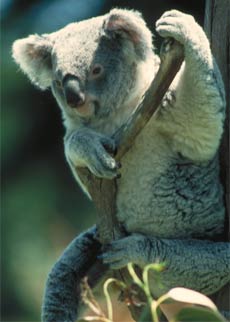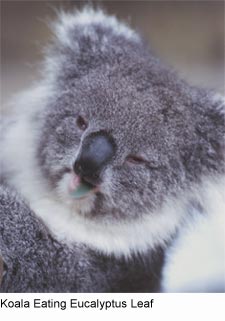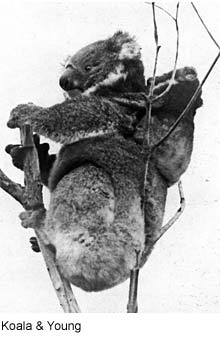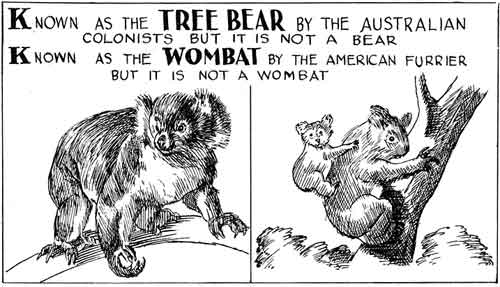|

 Just the Facts: The Koala is broadly similar in appearance to the wombat (its closest living relative), but has a thicker, softer coat, much larger ears, and longer limbs, which are equipped with large, sharp claws to assist with climbing. Weight varies from about 14 kg for a large, southern male, to about 5 kg for a small northern female. Contrary to popular belief, their fur is thick, not soft and cuddly. Just the Facts: The Koala is broadly similar in appearance to the wombat (its closest living relative), but has a thicker, softer coat, much larger ears, and longer limbs, which are equipped with large, sharp claws to assist with climbing. Weight varies from about 14 kg for a large, southern male, to about 5 kg for a small northern female. Contrary to popular belief, their fur is thick, not soft and cuddly.
Cough Drops? Much as the Flamingo's bright color comes from the carotene they eat, the Koala has been observed as smelling like large cough drops due to their diet of eucalyptus.
Barely a Brain: The Koala has an unusually small brain, with about 40% of the cranial cavity being filled with fluid, while the brain itself is like "a pair of shriveled walnut halves on top of the brain stem, in contact neither with each other nor the bones of the skull. It is the only animal on Earth with such a strangely reduced brain."

Where in the World? The Koala is found all along the eastern coast of Australia from near Adelaide to the southern part of Cape York Peninsula, and as far into the hinterland as there is enough rainfall to support suitable forests. The Koalas of South Australia were largely exterminated during the early part of the 20th century, but the state has since been repopulated with Victorian stock. The Koala is not found in Tasmania or Western Australia.
 Leaf: it's what's for dinner... The Koala lives almost entirely on eucalyptus leaves. This is likely to be an evolutionary adaptation that takes advantage of an otherwise unfilled ecological niche, since eucalyptus leaves are low in protein, high in indigestible substances, and contain phenolic and terpene compounds that are toxic to most species. Leaf: it's what's for dinner... The Koala lives almost entirely on eucalyptus leaves. This is likely to be an evolutionary adaptation that takes advantage of an otherwise unfilled ecological niche, since eucalyptus leaves are low in protein, high in indigestible substances, and contain phenolic and terpene compounds that are toxic to most species.
Like wombats and sloths, the Koala has a very low metabolic rate for a mammal (which conserves energy) and rests motionless for about 19 hours a day, sleeping most of that time. Koalas spend about 3 of their 5 active hours eating. It feeds at any time of day, but usually at night. An average Koala eats 500 grams of eucalyptus leaves each day, chewing them in its powerful jaws to a very fine paste before swallowing.
Digestion: The liver deactivates the toxic components ready for excretion, and the hind gut (especially the caecum) is greatly enlarged to extract the maximum amount of nutrient from the poor quality diet. Much of this is done through bacterial fermentation: when young are being weaned, the mother passes unusually soft feces, called pap, which is rich in these bacteria, thus passing these essential digestive aids onto her offspring.
Quiet Creatures: It is a generally silent creature, but males have a very loud advertising call that can be heard from almost a kilometer away during the breeding season. There is little reliable information about the lifespan of the Koala, but in captivity they have been observed to reach the age of 15 years.
Solitary Koalas: Females are solitary and occupy distinct home ranges that they rarely leave. In the more fertile areas, these ranges overlap; in areas where suitable food trees are scarce they tend to be larger and more exclusive. Males are not territorial, but do not tolerate one another, particularly not during the breeding season: dominant individuals attack subordinate ones, and most adult males carry scars on their face, ears and forearms as a result.
Tree Huggers: The Koala is almost entirely arboreal. It does not make nests, but sleeps in a tree fork or on a branch. It climbs using its powerful claws for grip, usually moving quite slowly but can climb rapidly when needed. The Koala will leap confidently from one tree to another if they are reasonably close together. Its climbing is aided by a pair of thumbs on each paw, and it is the only other animal aside from primates to possess fingerprints. Longer distances are traversed on the ground in a slow but effective waddle. If threatened, the Koala breaks into a surprisingly athletic gallop, heading for the nearest tree and bounding up it to a safe height. There the Koala waits for the intruder to go away with the patience of a creature that routinely sleeps for 18 hours a day. The Koala is also rather adept at swimming, but this has rarely been witnessed.

 Birds and Bees: Females reach sexual maturity at 2 to 3 years of age, males at 3 to 4 years. If healthy, a female Koala can produce one young each year for about Birds and Bees: Females reach sexual maturity at 2 to 3 years of age, males at 3 to 4 years. If healthy, a female Koala can produce one young each year for about
12 years. Gestation is 35 days; twins are very rare. Mating normally occurs between December and March, the Southern Hemisphere's summer.
Draw-string Pouch: A baby Koala is referred to as a joey and is hairless, blind, and earless. At birth the joey, only the size of a jelly bean, crawls into the downward-facing pouch on the mother's belly (which is closed by a drawstring-like muscle that the mother can tighten at will) and attaches itself to one of the two teats. Young remain hidden in the pouch for about six months, only feeding on milk. During this time they grow ears, eyes, and fur. The joey then begins to explore outside of the pouch.
Baby Food: At about 30 weeks it has begun to eat the semi-liquid form of the mother’s excrement called "pap". The baby Koala will remain with the mother for another six months or so, riding on her back, and feeding on both milk and gum leaves until weaning is complete at about 12 months of age. Young females disperse to nearby areas at that time; young males often stay in the mother's home range until they are two or three years old.

All text is available under the terms
of the GNU Free Documentation License
|